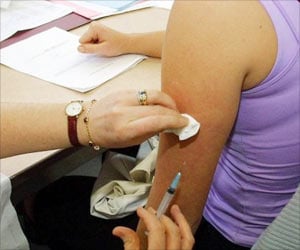Cervical Health Awareness Month in the US helps emphasize how women can protect themselves against cervical cancer and HPV infections.

All women are susceptible to cervical cancer and the main of cause of the cancer is Human Papillomavirus (HPV). HPV is a very common virus that gets transmitted through sexual intercourse. It infects the genital areas with no signs or symptoms and goes away on its own.
However, if HPV does not disappear, it turns out to be a potential risk factor for cervical cancer. HPV alters the normal cells into abnormal cells that could turn into cancer cells gradually. Cervical cancer does not show any symptoms until at an advanced stage, associated with signs of vaginal bleeding or increased discharge.
Cervical Cancer Screening
Cervical cancer is a highly preventable cancer and therefore, cancer screening is recommended for diagnosing the disease early. Regular screening tests and follow-up care can often prevent cervical cancer.There are two types of tests to detect cervical cancer early or prevent it. It includes,
- PAP Test
- HPV Test
The Papanicolaou test or PAP smear helps in identifying pre-cancer cells or abnormal cells before they turn into cancer cells. Women should get their first PAP test at the age of 21. It is generally recommended for women between 21-65-years-old. A Pap smear can only detect cervical cancer and not other gynecological cancers.
HPV test looks for Human papillomavirus (HPV) in the cervix and also pre-cancer cells. HPV test is not recommended for women below 30 years as the prevalence of HPV in them is higher. All women who have had sex will have the virus, about 79 million people are infected with HPV in the United States.
Interpreting Results:
If the PAP test result is normal or negative; it means that no cells were found to be abnormal and there is no risk of cervical cancer.
If the PAP test result is unclear; it means that the cervical cells look like they could be abnormal. Only after an HPV test the results can be interpreted.
If the PAP test result is abnormal or positive; it means that there are some abnormal cells on the cervix. But it does not mean that one may have cervical cancer. Only the more serious abnormal cells can turn into cancer cells, but they are not yet cancer.
A negative HPV test indicates the absence of HPV linked to cervical cancer. A positive HPV test indicates the presence of HPV linked to cervical cancer.
If the HPV test result is negative and
- PAP test result is negative; cervical cancer risk is minimal and one must wait for 5 years before testing again.
- PAP test result is unclear; the cells may be abnormal, but it is not linked to HPV.
- PAP test result is positive; the cells are abnormal in nature and risk of cervical cancer is high. These abnormal cells can be treated before they turn into cancerous cells.
- PAP test result is negative; the cells are normal but has HPV. The virus can disappear or alter the cells gradually. Therefore, get another Pap and HPV test in 1 year.
- PAP test result is unclear; the cells will be removed to prevent further infection.
- PAP test result is positive; it does not mean the cells are cancer. Doctor may monitor the cells using colposcopy or remove them to prevent cervical cancer.
Importance of HPV Vaccination
There is no treatment for HPV but it can be prevented using HPV vaccine. The HPV vaccine protects against the HPV types that most often cause cervical cancer. The two most common high-risk strains are HPV 16 and 18 and the two most common low-risk types are HPV 6 and 11.HPV vaccine is given in 3 shots. The vaccine is recommended for girls in the age group of 11-12 years. It can be given to women aged 13–26 who did not get any or all of the shots yet. Ideally, the vaccine must be given before the girl becomes sexually active. The HPV vaccine is also recommended for boys and young men. Pregnant women should not be administered with the HPV vaccine during pregnancy.
The stigma associated with vaccinating preteens prevents doctors from recommending the vaccine for teenagers. However, since preteens and teenagers do engage in sexual intercourse and as HPV transmission can also occur through contact with skin, administering the HPV vaccine to preteens will limit risk for HPV infections.
Important to note: Women who are already vaccinated with HPV must still undergo Pap tests as the vaccine does not prevent all types of HPV.
Ways to Prevent Cervical Cancer
- Consult a doctor regularly and undergo for cancer screening tests.
- Take routine Pap tests, at least once every 3 years or every 5 years along with the HPV tests.
- Follow up the tests with your doctor and get treatmented if required.
- Get screened for cancer even if you feel healthy or are undergoing menopause
- Quit smoking.
- Use condoms during sex.
- Limit the number of sexual partners.
- Create awareness about the importance of HPV vaccine for pre-teens among parents. Both boys and girls need the vaccine.
- Encourage healthcare providers to give free or reduced-cost “Pap Tests.”
References:
1. http://www.nccc-online.org/hpvcervical-cancer/cervical-health-awareness-month/2. http://www.cancer.org/cancer/cancercauses/othercarcinogens/infectiousagents/hpv
/humanpapillomavirusandhpvvaccinesfaq/index
3. http://www.cdc.gov/cancer/hpv/pdf/HPV_Testing_2012_English.pdf
4. http://www.cdc.gov/cancer/dcpc/resources/features/cervicalcancer/
5. http://www.cdc.gov/cancer/cervical/pdf/cervical_facts.pdf
6. http://www.cdc.gov/cancer/cervical/basic_info/infographic.htm
Source-Medindia











